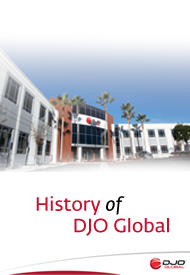DJO Global Announces Financial Results for Fourth Quarter and Fiscal Year End 2011
SAN DIEGO, CA, February 16, 2011 – DJO Global, Inc. (“DJO” or the “Company”), a leading global provider of medical device solutions for musculoskeletal health, vascular health and pain management, today announced financial results for its operating subsidiary, DJO Finance LLC (“DJOFL”), for the fourth quarter and fiscal year ended December 31, 2011.
Fourth Quarter Results
DJOFL achieved record net sales for the fourth quarter of 2011 of $284.2 million, reflecting growth of 13.7 percent compared to net sales of $249.8 million for the fourth quarter of 2010. Net sales for the fourth quarter of 2011 were unfavorably impacted by changes in foreign currency exchange rates compared to the rates in effect in the fourth quarter of 2010. Excluding the impact of foreign exchange rate changes (“constant currency”), net sales for the fourth quarter of 2011 increased 13.9 percent compared to net sales for the fourth quarter of 2010.
DJO’s fourth quarter of 2011 included net sales from businesses recently acquired, as follows: Elastic Therapy, Inc. (“ETI”), acquired on January 4, 2011, Circle City Medical (“Circle City”), acquired on March 10, 2011 and Dr. Comfort (“DRC”), acquired on April 7, 2011. On a pro forma basis, as if the acquisitions of ETI, Circle City and DRC had all closed on January 1, 2010, DJO net sales for the current quarter reflected growth of 3.1 percent over pro forma net sales of $275.5 million for the fourth quarter of 2010. In constant currency, net sales for the current quarter increased 3.3 percent compared with pro forma net sales in the fourth quarter of 2010. Sales to customers in the United States by all of the acquired businesses are included within the Company’s Bracing and Vascular segment, and sales to international customers are included within the Company’s International segment.
For the fourth quarter of 2011, DJOFL reported a net loss attributable to DJOFL of $148.2 million, compared to a net loss of $11.4 million for the fourth quarter of 2010. As detailed in the attached financial tables, the results for the current and prior year fourth quarter periods were impacted by significant non-cash items, non-recurring items and other adjustments. The results for the fourth quarter of 2011 included a non-cash pre-tax charge of $141.0 million to write-down the carrying value of the Company’s goodwill and other intangible assets to fair value as determined by the Company’s annual impairment test related to such assets.
The Company defines Adjusted EBITDA as net (loss) income attributable to DJOFL plus interest expense, net, income tax expense (benefit), and depreciation and amortization, further adjusted for certain non-cash items, non-recurring items and other adjustment items as permitted in calculating covenant compliance under the Company’s senior secured credit facility and the indentures governing its 10.875% and 7.75% senior notes and its 9.75% senior subordinated notes. Reconciliation between net loss and Adjusted EBITDA is included in the attached financial tables.
Adjusted EBITDA for the fourth quarter of 2011 set a new record for the Company at $74.5 million, or 26.2 percent of net sales, reflecting growth of 3.2 percent compared with Adjusted EBITDA of $72.2 million, or 28.9 percent of net sales, for the fourth quarter of 2010. Adjusted EBITDA for the fourth quarter of 2011 was unfavorably impacted by $0.1 million related to changes in foreign currency exchange rates compared to the rates in effect in the fourth quarter of 2010. Adjusted EBITDA and Adjusted EBITDA as a percentage of net sales (Adjusted EBITDA margin) in the current fourth quarter period were unfavorably impacted by a decrease in gross profit as a percentage of sales (gross profit margin) and also by certain operating expense investments made in the Company’s commercial infrastructure. Gross profit and gross profit margin for the fourth quarter of 2011 were favorably impacted by an adjustment made by the Company to reduce deferred gross profit from intercompany sales of inventory, which partially offset the unfavorable impact of certain changes in product mix compared to the prior year period, an increase in net freight expense and pricing pressure in certain product lines.
On a pro forma basis, as if the acquisitions of ETI, Circle City and DRC had all closed on January 1, 2010, DJO Adjusted EBITDA for the current quarter reflected a decline of 6.6 percent compared to pro forma Adjusted EBITDA of $79.7 million for the fourth quarter of 2010, due primarily to the operating expense investments discussed above.
As of December 31, 2011, the Company had cash balances of $38.2 million and available liquidity of $49.0 million under its revolving line of credit. Borrowings under the revolving line of credit have been reduced by an additional $10 million since December 31, 2011, increasing the available liquidity under the line.
“We are pleased to finish 2011 on a strong note with record revenue for the fourth quarter and surpassing $1.0 billion in full year revenue for the first time in DJO Global’s history. We saw improved momentum in all of our businesses in the fourth quarter, based on successful new product launches and improved commercial execution,” said Mike Mogul, DJO’s president and chief executive officer. “Headwinds in our Empi business unit continued to constrain our total net revenue growth in the fourth quarter, but we were pleased to see the Empi business deliver strong sequential growth in average daily sales of over 10% compared to average daily sales in the third quarter.
“Our teams are generating exciting success with new products recently launched, including our Exos range of upper extremity products incorporating thermoformable polymer technology and our Reaction™ knee brace for patients with anterior knee pain, both within our Bracing and Vascular segment, our first-to-market Compex® wireless muscle stimulator and our Shockwave™ clinical device in our International segment and our Turon™ shoulder product in our Surgical Implant segment. We expect these new products, and other important new products we are introducing in early 2012, to make strong contributions to accelerating DJO’s future revenue growth.
“All DJO Global business units grew by more than 4 percent in the fourth quarter with the exception of Empi, and several of our business units delivered growth in excess of 6 percent in the fourth quarter.
“Empi saw net sales decline by $3.0 million in the fourth quarter as compared to net sales in the prior year fourth quarter period. The decline in Empi revenue is primarily due to unfavorable decisions made by certain third party payors related to insurance pricing for certain products and a reported decrease in patient visits to physical therapy clinics, where many of the Empi products are dispensed. We are approaching anniversary dates for some of the Empi reimbursement changes, which should make future year-over-year sales comparisons more favorable, and we have other strategies in place, which should positively impact the Empi business in the medium to long-term.
“Having just finished a highly successful National Sales Meeting and American Academy of Orthopedic Surgeons meeting, we have become increasingly optimistic about the depth and breadth of opportunities available to add value to our customers and to accelerate DJO’s revenue growth. In addition to the benefits we expect from the new products we are currently launching, we see many opportunities to further improve our commercial execution, to develop additional new products and services and to expand our market penetration with our strong commercial footprint. We expect these opportunities to positively impact our reported growth rates in 2012.”
Sales by Business Segment
With the addition of the recent acquisitions, DJO’s Bracing and Vascular segment reported 33.6% sales growth in the fourth quarter of 2011, compared to the fourth quarter of 2010. On a pro forma basis, as if all of the acquisitions had closed at the beginning of the fourth quarter in 2010, current quarter revenue in the Bracing and Vascular segment increased 4.4% compared with pro forma sales in the fourth quarter of the prior year.
Primarily as a result of declining sales within the Empi business, sales for the Recovery Sciences segment contracted by 0.6% compared to the fourth quarter of 2010. The CMF bone growth stimulation and Chattanooga business units, also included within the Recovery Sciences segment, continue to show strong growth, with aggregate growth of over 6 percent compared to the prior year fourth quarter.
Fourth quarter sales within the International segment were strong at $71.9 million, growing 11.4% over the prior year period. This result included the international component of the ETI and DRC acquisitions, partially offset by the impact of unfavorable changes in foreign exchange rates from rates in effect in the fourth quarter of 2010. In constant currency and on a pro forma basis for the acquisitions, growth over pro forma sales in the prior year fourth quarter was 6.3% for the international segment.
Surgical Implant segment sales were $16.8 million in the fourth quarter, growing 4.9% over the fourth quarter of 2010.
2011 Full Year
DJOFL achieved record net sales of $1,074.8 million for fiscal year 2011, reflecting growth of 11.3 percent compared to net sales of $966.0 million for fiscal year 2010. Net sales for fiscal year 2011 were favorably impacted by changes in foreign currency exchange rates compared to the rates in effect in fiscal year 2010. Fiscal year 2011 included 252 shipping days compared to 253 days in fiscal year 2010. In constant currency, average daily sales for fiscal year 2011 increased 11.7 percent compared to average daily sales for fiscal year 2010.
DJO’s fiscal year 2011 included net sales from businesses recently acquired. On a pro forma basis, as if the acquisitions of ETI, Circle City and DRC had closed on January 1, 2010, DJO net sales would have been $1,095.4 million for fiscal year 2011 and $1,070.8 million for fiscal year 2010, reflecting growth in pro forma average daily sales for fiscal year 2011 of 2.7 percent, or 1.6 percent in constant currency, over pro forma average daily sales in fiscal year 2010.
For the year ended December 31, 2011, DJOFL reported a net loss attributable to DJOFL of $214.5 million, compared to a net loss attributable to DJOFL of $52.5 million for the twelve months of 2010. As detailed in the attached financial tables, the results for the current and prior year twelve month periods were impacted by significant non-cash items, non-recurring items and other adjustments.
For the year ended December 31, 2011 (LTM), Adjusted EBITDA was $278.0 million, or 25.4 percent of LTM pro forma net sales of $1,095.4 million, including LTM pre-acquisition Adjusted EBITDA from recently acquired businesses of $7.9 million and future cost savings expected to be achieved related to the acquired businesses of $5.9 million.
Conference Call Information
DJO has scheduled a conference call to discuss this announcement beginning at 1 PM, Eastern Time today, February 16, 2012. Individuals interested in listening to the conference call may do so by dialing (866) 394-8509 (International callers please use (706) 643-6833), using the reservation code 22322226. A telephone replay will be available for 48 hours following the conclusion of the call by dialing (855) 859-2056 and using the above reservation code. The live conference call and replay will be available via the Internet at www.DJOglobal.com.
About DJO Global
DJO Global is a leading global developer, manufacturer and distributor of high-quality medical devices that provide solutions for musculoskeletal health, vascular health and pain management. The Company’s products address the continuum of patient care from injury prevention to rehabilitation after surgery, injury or from degenerative disease, enabling people to regain or maintain their natural motion. Its products are used by orthopedic specialists, spine surgeons, primary care physicians, pain management specialists, physical therapists, podiatrists, chiropractors, athletic trainers and other healthcare professionals. In addition, many of the Company’s medical devices and related accessories are used by athletes and patients for injury prevention and at-home physical therapy treatment. The Company’s product lines include rigid and soft orthopedic bracing, hot and cold therapy, bone growth stimulators, vascular therapy systems and compression garments, therapeutic shoes and inserts, electrical stimulators used for pain management and physical therapy products. The Company’s surgical division offers a comprehensive suite of reconstructive joint products for the hip, knee and shoulder. DJO Global’s products are marketed under a portfolio of brands including Aircast®, Chattanooga, CMF™, Compex®, DonJoy®, Empi®, ProCare®, DJO® Surgical and Dr. Comfort®.
Safe Harbor Statement
This press release contains forward-looking statements within the meaning of Section 27A of the Securities Act of 1933, as amended, and Section 21E of the Securities Exchange Act of 1934, as amended. Such statements relate to, among other things, the Company’s expectations for its businesses relative to current market conditions and global economic conditions; its opportunities to improve commercial execution, to develop new products and services and to expand its market penetration; the impact from the Company’s acquisition strategy on revenue growth and profitability and future cost savings expected to be achieved related to the acquisitions; and the impact from steps taken to reduce operating expenses to better match current global market conditions and to make funds available to invest in future growth opportunities. The words “believe,” “will,” “should,” “expect,” “intend,” “estimate” and “anticipate,” variations of such words and similar expressions identify forward-looking statements, but their absence does not mean that a statement is not a forward-looking statement. These forward-looking statements are based on the Company’s current expectations and are subject to a number of risks, uncertainties and assumptions, many of which are beyond the Company’s ability to control or predict. The Company undertakes no obligation to update any forward-looking statements, whether as a result of new information, future events or otherwise. The important factors that could cause actual operating results to differ significantly from those expressed or implied by such forward-looking statements include, but are not limited to; the successful execution of the Company’s business strategies relative to its Bracing and Vascular, Recovery Sciences, International and Surgical Implant segments; the continued growth of the markets the Company addresses and any impact on these markets from changes in global economic conditions; the successful execution of the Company’s sales and acquisition strategies; the Company’s highly leveraged financial position resulting primarily from the indebtedness incurred in connection with the November 2007 merger of ReAble Therapeutics, Inc. and DJO Global, (the “DJO Merger”), recent notes offering, and other recent acquisitions; the impact on the Company and its customers from changes in global credit markets; the impact of potential reductions in reimbursement levels by Medicare and other governmental and commercial payors; the Company’s ability to successfully develop, license or acquire, and timely introduce and market new products or product enhancements; risks associated with the implementation of the Company’s new ERP system; risks relating to the Company’s international operations; resources needed and risks involved in complying with government regulations and in developing and protecting intellectual property; the impact of a previously-announced pending government investigation and related private lawsuit concerning industry reimbursement and marketing practices in the bone growth stimulation market; the availability and sufficiency of insurance coverage for pending and future product liability claims, including multiple lawsuits related to the Company’s cold therapy products and its discontinued pain pump business; and the effects of healthcare reform, Medicare competitive bidding, managed care and buying groups on the prices of the Company’s products. These and other risk factors related to DJO are detailed in the Company’s Annual Report on Form 10-K for the year ended December 31, 2010, filed on March 3, 2011 with the Securities and Exchange Commission. Many of the factors that will determine the outcome of the subject matter of this press release are beyond the Company’s ability to control or predict.
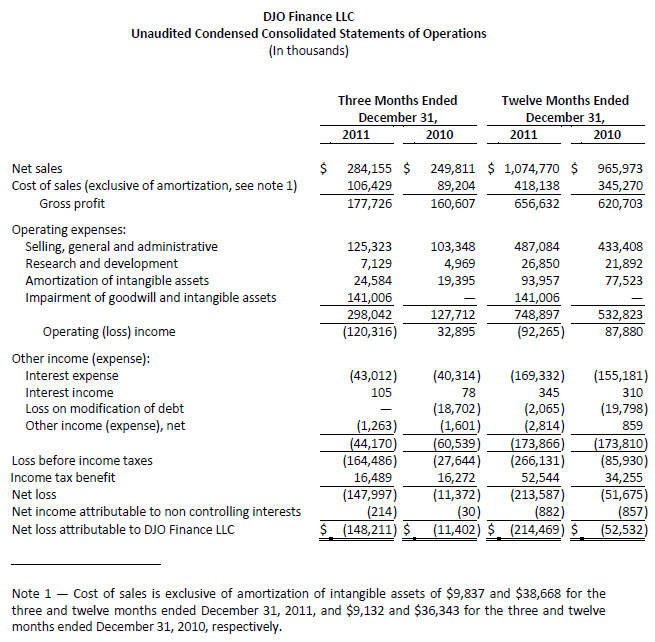
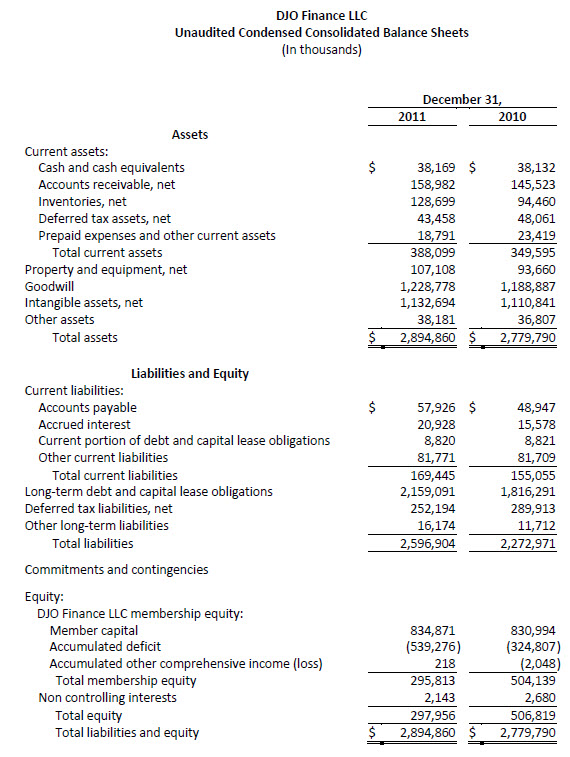
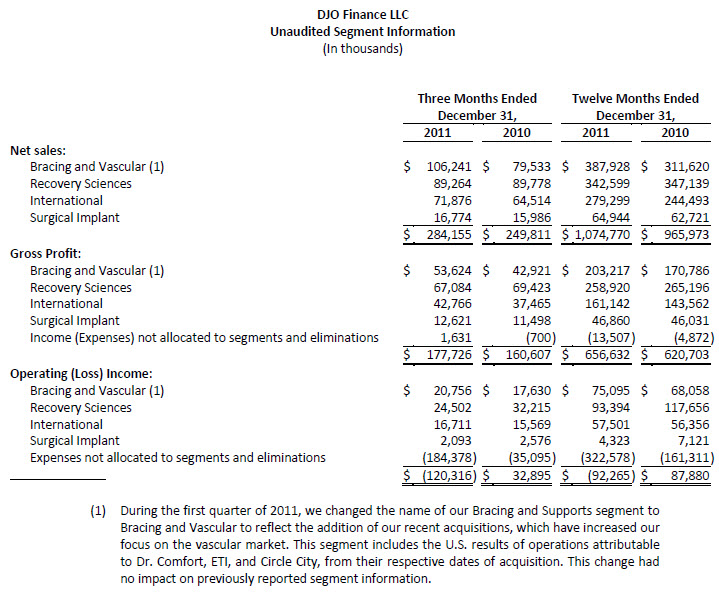
DJO Finance LLC
Adjusted EBITDA
For the Three Months and Twelve Months Ended December 31, 2011 and December 31, 2010
(unaudited)
Our Senior Secured Credit Facility, consisting of an $843.0 million term loan and a $100.0 million revolving credit facility, under which $51.0 million was outstanding as of December 31, 2011, and the Indentures governing our $675.0 million and $300.0 million of 10.875% and 7.75% senior notes, respectively, and $300.0 million of 9.75% senior subordinated notes represent significant components of our capital structure. Under our Senior Secured Credit Facility, we are required to maintain specified senior secured leverage ratios, which become more restrictive over time, and which are determined based on our Adjusted EBITDA. If we fail to comply with the senior secured leverage ratio under our Senior Secured Credit Facility, we would be in default. Upon the occurrence of an event of default under the Senior Secured Credit Facility, the lenders could elect to declare all amounts outstanding under the Senior Secured Credit Facility to be immediately due and payable and terminate all commitments to extend further credit. If we were unable to repay those amounts, the lenders under the Senior Secured Credit Facility could proceed against the collateral granted to them to secure that indebtedness. We have pledged a significant portion of our assets as collateral under the Senior Secured Credit Facility. Any acceleration under the Senior Secured Credit Facility would also result in a default under the Indentures governing the notes, which could lead to the note holders electing to declare the principal, premium, if any, and interest on the then outstanding notes immediately due and payable. In addition, under the Indentures governing the notes, our ability to engage in activities such as incurring additional indebtedness, making investments, refinancing subordinated indebtedness, paying dividends and entering into certain merger transactions is governed, in part, by our ability to satisfy tests based on Adjusted EBITDA. Our ability to meet the covenants specified above will depend on future events, many of which are beyond our control, and we cannot assure you that we will meet those covenants.
Adjusted EBITDA is defined as net income (loss) attributable to DJO Finance LLC plus interest expense, net, income tax expense (benefit), and depreciation and amortization, further adjusted for certain non-cash items, non-recurring items and other adjustment items as permitted in calculating covenant compliance and other ratios under the Company’s Senior Secured Credit Facility and the Indentures governing its 10.875% and 7.75% senior notes and its 9.75% senior subordinated notes. We believe that the presentation of Adjusted EBITDA is appropriate to provide additional information to investors about the calculation of, and compliance with, certain financial covenants and other ratios in our Senior Secured Credit Facility and the Indentures. Adjusted EBITDA is a material component of these calculations.
Adjusted EBITDA should not be considered as an alternative to net income (loss) or other performance measures presented in accordance with accounting principles generally accepted in the United States of America (“GAAP”), or as an alternative to cash flow from operations as a measure of our liquidity. Adjusted EBITDA does not represent net income (loss) or cash flow from operations as those terms are defined by GAAP and does not necessarily indicate whether cash flows will be sufficient to fund cash needs. In particular, the definition of Adjusted EBITDA under our Senior Secured Credit Facility and the Indentures allows us to add back certain non-cash, extraordinary, unusual or non-recurring charges that are deducted in calculating net income (loss). However, these are expenses that may recur, vary greatly and are difficult to predict. While Adjusted EBITDA and similar measures are frequently used as measures of operations and the ability to meet debt service requirements, Adjusted EBITDA is not necessarily comparable to other similarly titled captions of other companies due to the potential inconsistencies in the method of calculation.
The following table provides reconciliation between net loss and Adjusted EBITDA:
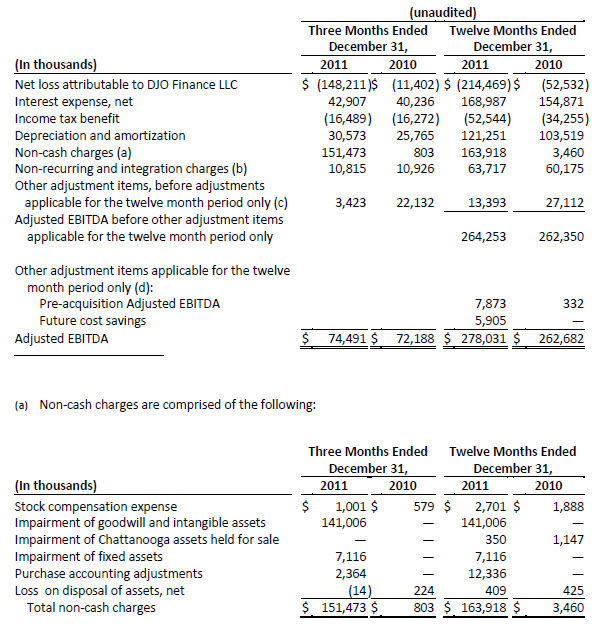

(1) Loss on modification of debt for the twelve months ended December 31, 2011 is comprised of arrangement and lender consent fees associated with the February 2011 amendment of our Senior Secured Credit Facility, which increased the total net leverage ratio limitation in the permitted acquisitions covenant from 6.0x to 7.0x, and deemed the ETI acquisition to have been made as a permitted acquisition. Loss on modification of debt for the twelve months ended December 31, 2010 is comprised of $13.0 million of premiums, $4.3 million for a non-cash write-off of unamortized debt issuance costs, $1.4 million of fees and expenses associated with the redemption of our $200.0 million of 11.75% senior subordinated notes in October 2010, and $1.1 million of fees and expenses related to the prepayment of $101.5 million of our term loan in January 2010.
(2) Other adjustments consist primarily of net realized and unrealized foreign currency transaction gains and losses.
(d) Other adjustment items applicable for the twelve month period only include pre-acquisition Adjusted EBITDA and future cost savings related to the acquisitions of Dr. Comfort, ETI, and Circle City.
